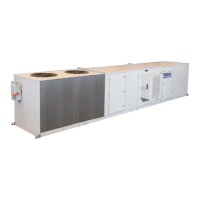Do you have a question about the PoolPak PCP Series and is the answer not in the manual?
Provides essential safety guidelines, warnings, cautions, and notes for operating the dehumidifier.
Critical safety warning for installation and service contractors regarding equipment work.
Important safety caution for the maintenance team regarding equipment upkeep.
Provides contact details for PoolPak for inquiries, support, and service.
Details the general views and options for S Cab dehumidifiers, including connections.
Details the vertical configuration for RV and RH Cabs, including airflow and piping connections.
Details the horizontal configuration for RV and RH Cabs, including airflow and piping connections.
Details the horizontal composition for BH and BV cabs, including airflow and piping connections.
Details the vertical configuration for BH and BV cabs, including airflow and piping connections.
Explains provisions for external systems connections for S Cab, including ductwork and piping.
Highlights the importance of maintaining proper clearances and dimensions for operation and service.
Lists various options applicable to RV/RH cabs, including capacity, airflow, and heating.
Illustrates standard and mirrored cabinet arrangements for RH and RV Cabs.
Lists various options applicable to BH and BV cabs, including capacity, airflow, and heating.
Explains provisions for external systems connections, including ductwork and piping.
Details the availability and configuration of two-compressor arrangements for PCP series dehumidifiers.
Details the Air Conditioning option using Outdoor Air Condensers (OACC) and their combinations.
Details the Air Conditioning option using Fluid Coolers (OAFC) and their combinations.
Details the layout of pump packages for fluid coolers, including pump, expansion tank, and electrical sub-panel.
Details the information found on the main manufacturer tag attached to the dehumidifier.
Describes various labels and stickers found on the dehumidifier, indicating connections and filters.
Illustrates and labels the main components of the dehumidifier in the S cab configuration.
Illustrates and labels the main components of the dehumidifier in the RV and RH cab configurations.
Illustrates and labels the main components of the dehumidifier in the BV and BH cab configurations.
Details the temperature sensors (thermistors) and combo sensors used for monitoring parameters.
Explains the use of pressure transducers and switches for monitoring compressor operation.
Measures temperature and humidity of return air entering the dehumidifier.
Measures outdoor air temperature, with an optional combo sensor for humidity.
Measures the temperature of air leaving the evaporator coil.
Measures the temperature of air supplied to the premise.
Measure entering and leaving pool water temperature for pool heating option.
Explains how the control system adjusts operation to maintain desired parameters and set points.
Details the ventilation sequence, including main blower operation and outdoor air intake.
Covers operation of compressor, evaporator, and heat rejection to various sinks.
Describes the sequence of operation for the compressor circuit.
Explains how outdoor condenser or fluid cooler fans are engaged based on control system signals.
Details the Touch Display Operator Panel as the main interface for dehumidifier operation and monitoring.
Outlines the different menus available on the Touch Display OP for navigation and control.
Lists common maintenance tasks that can be performed using the Touch Display OP interface.
Discusses remote communication capabilities via Virtual-Tech and BMS.
Explains Virtual-Tech as an online tool for remote monitoring, data collection, and parameter adjustment.
Discusses communication capabilities with Building Management Systems (BMS) via protocols like BACnet and LON.
Provides guidelines for essential preventative maintenance tasks and safety precautions.
Provides safety guidelines for qualified personnel performing maintenance tasks on the equipment.
Highlights essential maintenance considerations, including chemical storage and equipment accessibility.
Emphasizes the importance of correct pool water chemistry for equipment longevity and warranty.
Guides on creating a facility-specific routine maintenance program based on recommended tasks and intervals.
Details maintenance for filters, including ensuring cleanliness and proper replacement.
Covers inspection of dehumidifier insulation for microbial growth and replacement if needed.
Provides instructions and warnings for cleaning air-side coils, including chemical and pressure safety.
Provides guidance on draining fluid coolers to protect against freezing during low temperatures.
Outlines the general policy for PoolPak service and warranty work, managed by Dehumidified Air Services (DASV).
Explains that warranties are void unless equipment start-up is approved and registered.
Details the comprehensive warranty coverage for parts and repairs during the first 90 days after start-up.
Describes an extended repair warranty contingent on the equipment being connected to the internet.
Covers replacement parts for defects for up to 24 months from warranty activation date.
Details the warranty coverage for replacement parts provided by PoolPak.
Specifies the applicability of the warranty, including what it covers and what it excludes.
Outlines limitations of the warranty, including service response and events beyond control.
Details optional extended warranties for specific components like compressors, coils, and driveline parts.
| Application | Indoor Pool Dehumidification |
|---|---|
| Model Series | PCP Series |
| Category | Dehumidifier |
| Refrigerant | R-410A |
| Phase | 3-Phase |
| Airflow | Varies by model |
| Heat Rejection Options | Air-cooled, Water-cooled |
| Control System | Microprocessor-based |
| Construction | Galvanized steel |
| Insulation | Closed-cell foam |
| Certifications | ETL |
